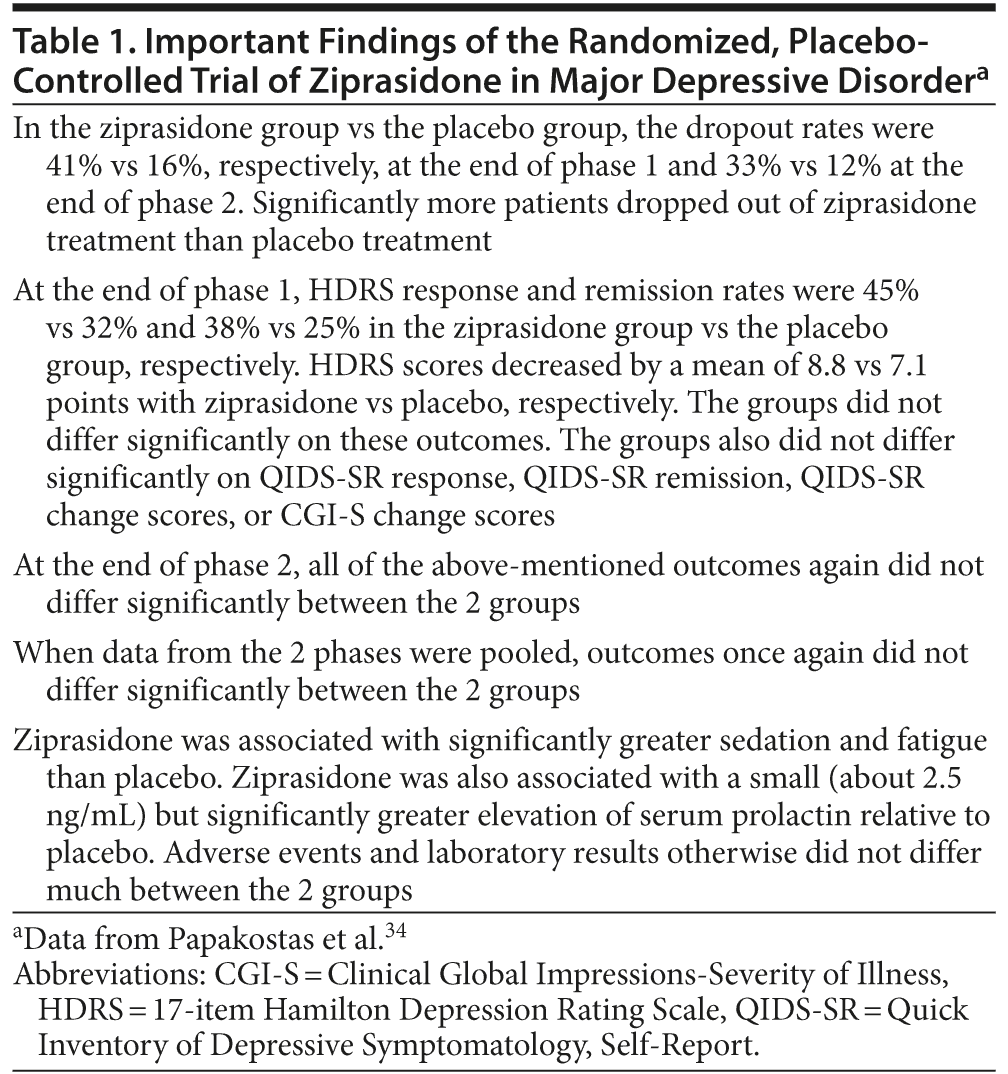Ziprasidone has many pharmacodynamic properties that suggest it may have antidepressant action. Ziprasidone has established antimanic efficacy, and therefore, there is reason to hope that ziprasidone may be useful in the treatment of depression, especially when there is a risk of a switch into mania. A recent randomized controlled trial (RCT), however, found that ziprasidone monotherapy was no better than placebo in patients with major depressive disorder. Earlier RCTs had found ziprasidone to be ineffective in bipolar depression. These findings do not encourage the use of ziprasidone monotherapy to treat depression. Assuming that these findings are valid, a second take-home message is that clinicians should not rely too much on pharmacodynamic properties to guide expectations of clinical efficacy. Last, but not least, a note is presented on how evidence-based medicine principles should be applied in the interpretation of the results of the ziprasidone RCT in major depressive disorder with regard to a clinical case in point.

- Ziprasidone has established antimanic efficacy. It also has pharmacodynamic properties that suggest that it may have antidepressant action. Hypothetically, therefore, ziprasidone may be useful in depressive illness, especially bipolar depression.
- A recent RCT found ziprasidone to be no better than placebo in major depressive disorder. Earlier RCTs had found it ineffective in bipolar depression, as well.
- The results to date with ziprasidone suggest that clinicians should not rely too much on pharmacodynamic properties to guide expectations about the clinical efficacy of a drug. Due to limitations of the available RCT data, however, firm conclusions remain to be drawn regarding the use of ziprasidone in different contexts in depression.
Clinical Problem
Mr J is a 44-year-old man who experienced a manic episode 8 years earlier. He discontinued sodium valproate maintenance therapy, because of weight gain, after about 1 year of medication use. He is presently experiencing his first major depressive episode, which is moderately severe in intensity. Mr J is reluctant to accept quetiapine because of the risks of sedation and weight gain associated with the drug. Ziprasidone is less likely to result in sedation and weight gain than quetiapine. Might Mr J respond to monotherapy with ziprasidone?
Why Consider an Atypical Antipsychotic for Patients With Bipolar Depression?
The use of antidepressant drugs is generally discouraged in bipolar depression because there is no clear evidence of antidepressant benefit (especially when the patient is receiving an adequate dose of a mood stabilizer)1-3 and because there is a risk of manic switch and cycle acceleration.4-6 Lamotrigine is a candidate treatment7; however, one concern is that lamotrigine needs to be slowly up-titrated to the target dose to reduce the risk of serious rash,8 and another concern is that lamotrigine may not be a good antidepressant during the acute phase of illness because it was superior to placebo in only 1 of 5 randomized controlled trials (RCTs) conducted in patients with bipolar depression9 and in none of 3 RCTs conducted in patients with major depressive disorder (MDD).10
Antipsychotic drugs are effective against mania; therefore, an advantage of using an atypical antipsychotic to treat a bipolar depressive episode is that the risk of manic switch could be expected to be lower. The atypical antipsychotic quetiapine is a serious first-line contender because it is effective in the acute phase of bipolar depression3,11-13 and because it can afterward be continued as maintenance therapy.14-16 Quetiapine has demonstrated efficacy when used as monotherapy3,11-13,16 as well as when used to augment lithium or valproate.14,15 Olanzapine is another atypical antipsychotic with possible efficacy in bipolar depression,17,18 especially when used in combination with fluoxetine.17
Atypical antipsychotics, in fact, may also be helpful for MDD, both as monotherapy, as in the case of quetiapine,19,20 and as antidepressant augmentation agents, as in the cases of quetiapine21 and aripiprazole.22 Quetiapine is also effective in the maintenance therapy of MDD.23 Atypical antipsychotic agents as a class may be effective for antidepressant augmentation of nonpsychotic MDD24,25 and may be more effective for antidepressant augmentation than the use of a second antidepressant.26
Preclinical Reasons Why Ziprasidone May Be Considered for Patients With Depression
Ziprasidone inhibits the synaptic reuptake of serotonin and norepinephrine and blocks 5-HT2A, 5-HT2C, and 5-HT1D receptors.27 Ziprasidone-induced agonism at 5-HT1A receptors increases dopamine levels in the prefrontal cortex.28 Ziprasidone may also block synaptic reuptake of dopamine.29 All of these properties suggest antidepressant potential. For example, inhibition of the synaptic reuptake of monoamines is the proposed mechanism of action of tricyclic antidepressants, selective serotonin reuptake inhibitors, bupropion, and many other newer as well as older antidepressant drugs.30,31 Blockade of 5-HT2A and 5-HT2C receptors results in increased levels of dopamine, serotonin, and norepinephrine in the prefrontal cortex,32,33 which may also contribute to antidepressant action.31
Ziprasidone and Major Depressive Disorder
The best evidence for the clinical efficacy of a drug can come only from RCT data. In the only study to date on the subject, Papakostas et al34 described an industry-sponsored, multicenter, 12-week, randomized, double-blind, placebo-controlled trial of ziprasidone in patients with DSM-IV MDD.
The sample comprised 120 adult outpatients, none of whom had significant medical, psychiatric, or substance use comorbidity. The mean age of the sample was 44 years, and the sample was 56% male. Patients were, on average, mildly depressed at baseline (mean 17-item Hamilton Depression Rating Scale [HDRS] score = 19.9).
These patients were randomized 2:3:3 to receive ziprasidone for 12 weeks, or placebo for 6 weeks followed by ziprasidone for 6 weeks, or placebo for 12 weeks. During the first 6 weeks (phase 1), there were 29 ziprasidone and 91 placebo patients. During the next 6 weeks (phase 2), when only phase 1 HDRS nonresponders were the subjects of interest, there were 21 ziprasidone and 25 placebo patients.
Ziprasidone was initiated at 40 mg/d, and the dose was raised by 40 mg/d at weekly intervals at the discretion of the treating clinician, with a ceiling of 160 mg/d. The mean maximum dose of ziprasidone was 81 mg/d during phase 1 and 114 mg/d during phase 2.
Response was defined as at least 50% improvement on the HDRS and the Quick Inventory of Depressive Symptomatology, Self-Report (QIDS-SR). Remission was defined as a final HDRS score of 7 or less or a QIDS-SR score of 5 or less.
The findings of the study are summarized in Table 1. In brief, ziprasidone was not significantly superior to placebo on any efficacy outcome in either phase of the study or in a pooled analysis that employed a special, weighted statistical model. Notably, significantly more patients dropped out of ziprasidone treatment than placebo treatment.
The authors34 offered several reasons why ziprasidone failed to demonstrate antidepressant efficacy; one was that the drug may have been underdosed, and another was that patients were not exposed to the highest dose for a sufficiently long period. The high dropout rate with ziprasidone and the sequential design also resulted in underpowered analyses. For all of these reasons and more, the findings of this study are not the last word on the subject. Nevertheless, the findings do not encourage the use of ziprasidone to treat a major depressive episode.
Ziprasidone and Bipolar Depression
Encouraging results were obtained in an open, uncontrolled study of ziprasidone monotherapy in bipolar II depression.35 However, RCT results for ziprasidone in bipolar depression have disappointed academia and industry, alike. Sachs et al36 described a 6-week RCT which found that ziprasidone (mean dose = 90 mg/d) augmentation of a mood stabilizer was ineffective in adults with bipolar depression. Lombardo et al37 attempted to explain the failure of two 6-week RCTs comparing ziprasidone with placebo in adults with bipolar I depression. One of these studies examined 2 different doses of ziprasidone (40-80 mg/d and 120-160 mg/d), and the other examined flexible dosing with ziprasidone (40-160 mg/d). Response rates ranged from 46% to 53% in the first study and 51% to 53% in the second study; ziprasidone was no better than placebo in either study. Sachs et al36 and Lombardo et al37 reported serious inconsistencies in clinical ratings and recruitment matters that may have limited the ability of the RCTs to detect a difference between ziprasidone and placebo. It is therefore uncertain whether these RCTs can contribute meaningfully to decision-making on the use of ziprasidone in bipolar depression.
Limitations of Pharmacodynamics as a Predictor of Clinical Actions
As reviewed earlier in this article, ziprasidone has many pharmacodynamic properties that are common to drugs with established antidepressant action. Ziprasidone also showed antidepressant efficacy in a 1-(m-chlorophenyl)piperazine animal model of depression.38 Finally, other atypical antipsychotics show antidepressant action despite boasting of less impressive putative antidepressant mechanisms than ziprasidone. Yet, ziprasidone showed no antidepressant advantage over placebo in the MDD34 and bipolar depression36,37 RCTs described in the earlier sections. Important take-home messages are that preclinical research and circumstantial evidence can only guide hypothesis generation, and antidepressant action is not a class action of atypical antipsychotic drugs. Expressed as a delightfully mixed metaphor, the proof of the pudding can come only from the results of good clinical research.
Readers are reminded of how scores of prospective drugs with excellent preclinical credentials fail to make it to the market because of disappointing phase 2 and phase 3 clinical trial results. Thus, the failure of ziprasidone to separate from placebo in unipolar and bipolar depression is an outcome that academia and the industry must take in their stride.
An Evidence-Based Appraisal
It is incorrect to draw conclusions about apples from a study of oranges. The results of a study can only be generalized to the population from which the study was drawn, and then only if the same methods are employed. So, was the study of ziprasidone in MDD34 appropriate to Mr J, the patient described at the start of this article? Perhaps not. The most important concern is diagnosis. Mr J has bipolar depression, and the Papakostas et al34 study was conducted in patients with MDD. That diagnosis is a relevant issue should be evident from the lamotrigine RCT results for unipolar and bipolar depression, referred to in an earlier section.
Another important concern addresses severity of depression. The ziprasidone MDD study34 was conducted in patients who were but mildly depressed (mean HDRS score at baseline = 19.9); this may be an important reason why the trial failed, for a meta-analysis of antidepressant RCTs submitted to the US Food and Drug Administration found that antidepressant drugs separate better from placebo only when depression is more severe.39 Thus, given that Mr J has moderately severe depression, the ziprasidone MDD study34 provides little guidance on how patients with moderately severe depression might fare on monotherapy with the drug. Finally, the study provides no information on possible benefits with faster up-titration or higher doses of ziprasidone (which, however, could result in even higher dropout rates than those recorded in the study).
The ziprasidone bipolar depression studies36,37 were considered flawed by their authors themselves and therefore should not be used as evidence to guide decision-making. So, if the ideal evidence is unavailable, the next best evidence that is available should be applied to the clinical problem at hand. Under these circumstances, the ziprasidone MDD study34 comes closest to providing guidance about the use of ziprasidone for Mr J. Readers are reminded here that using “next-best evidence” is widespread in clinical psychopharmacology. For examples, RCTs on which drug approvals are based almost always exclude very severely ill patients, those who are suicidal, those with significant medical or psychiatric comorbidities, those with substance use or personality disorders, and so on; that is, a substantial proportion of patients seen in everyday clinical practice.
Here are some additional notes on apples and oranges in the interpretation of research. What if Mr J had bipolar depression with psychotic features? It would seem that an atypical antipsychotic with proven antidepressant action would be even more appropriate as a monotherapy option because the antipsychotic action of the drug could take care of the psychotic symptoms and the antidepressant action could target the depression. However, patients with psychotic depression are generally excluded from RCTs, and so there is little to no high-quality evidence to support such a conjecture. In one RCT,40 however, olanzapine monotherapy was inferior to an olanzapine-sertraline combination in psychotic depression.
Parting Notes
The preceding discussion explains why the last word remains to be written on the subject of the antidepressant efficacy of ziprasidone. Antidepressant drugs tend to separate from placebo only when depression is more severe.39 Lamotrigine failed in MDD but enjoys a therapeutic role in bipolar depression.41 Aripiprazole can be used for antidepressant augmentation in refractory MDD.22 Ziprasidone remains to be studied in more severely depressed patients with MDD, in properly conducted RCTs in bipolar depression, and as an antidepressant augmentation agent—3 situations in which it may yet be found to have a role. As remarked earlier, for the best chance for successful trials, patients will need to be exposed to an adequate dose of the drug for an adequate duration.
On a positive note: a very recent RCT found that ziprasidone augmentation was superior to placebo augmentation in patients with a depressive mixed state.42 And, on a negative note, aripiprazole, another atypical antipsychotic drug with good antidepressant credentials,22 failed in two 8-week monotherapy RCTs in bipolar I depression,43 reemphasizing the point that pharmacodynamics and circumstantial evidence do not necessarily indicate clinical efficacy.
J Clin Psychiatry 2013;74(3):e193-e196 (doi:10.4088/JCP.13f08410)
© Copyright 2013 Physicians Postgraduate Press, Inc.
 Each month in his online column, Dr Andrade considers theoretical and practical ideas in clinical psychopharmacology with a view to update the knowledge and skills of medical practitioners who treat patients with psychiatric conditions.
Each month in his online column, Dr Andrade considers theoretical and practical ideas in clinical psychopharmacology with a view to update the knowledge and skills of medical practitioners who treat patients with psychiatric conditions.
Department of Clinical Psychopharmacology and Neurotoxicology, National Institute of Mental Health and Neurosciences, Bangalore, India ([email protected]).
Financial disclosure and more about Dr Andrade.
REFERENCES
1. Nemeroff CB, Evans DL, Gyulai L, et al. Double-blind, placebo-controlled comparison of imipramine and paroxetine in the treatment of bipolar depression. Am J Psychiatry. 2001;158(6):906-912. PubMed doi:10.1176/appi.ajp.158.6.906
2. Sachs GS, Nierenberg AA, Calabrese JR, et al. Effectiveness of adjunctive antidepressant treatment for bipolar depression. N Engl J Med. 2007;356(17):1711-1722. PubMed doi:10.1056/NEJMoa064135
3. McElroy SL, Weisler RH, Chang W, et al; EMBOLDEN II (Trial D1447C00134) Investigators. A double-blind, placebo-controlled study of quetiapine and paroxetine as monotherapy in adults with bipolar depression (EMBOLDEN II). J Clin Psychiatry. 2010;71(2):163-174. PubMed doi:10.4088/JCP.08m04942gre
4. Wehr TA, Goodwin FK. Can antidepressants cause mania and worsen the course of affective illness? Am J Psychiatry. 1987;144(11):1403-1411. PubMed
5. Altshuler LL, Post RM, Leverich GS, et al. Antidepressant-induced mania and cycle acceleration: a controversy revisited. Am J Psychiatry. 1995;152(8):1130-1138. PubMed
6. Goldberg JF, Truman CJ. Antidepressant-induced mania: an overview of current controversies. Bipolar Disord. 2003;5(6):407-420. PubMed doi:10.1046/j.1399-5618.2003.00067.x
7. Geddes JR, Calabrese JR, Goodwin GM. Lamotrigine for treatment of bipolar depression: independent meta-analysis and meta-regression of individual patient data from five randomised trials. Br J Psychiatry. 2009;194(1):4-9. PubMed doi:10.1192/bjp.bp.107.048504
8. Calabrese JR, Sullivan JR, Bowden CL, et al. Rash in multicenter trials of lamotrigine in mood disorders: clinical relevance and management. J Clin Psychiatry. 2002;63(11):1012-1019. PubMed doi:10.4088/JCP.v63n1110
9. Calabrese JR, Huffman RF, White RL, et al. Lamotrigine in the acute treatment of bipolar depression: results of five double-blind, placebo-controlled clinical trials. Bipolar Disord. 2008;10(2):323-333. PubMed doi:10.1111/j.1399-5618.2007.00500.x
10. Shelton MD, Calabrese JR. Lamotrigine use in psychiatry. Prim Psychiatry. 2002;9(1):50-53.
11. Calabrese JR, Keck PE Jr, Macfadden W, et al. A randomized, double-blind, placebo-controlled trial of quetiapine in the treatment of bipolar I or II depression. Am J Psychiatry. 2005;162(7):1351-1360. PubMed doi:10.1176/appi.ajp.162.7.1351
12. Suppes T, Datto C, Minkwitz M, et al. Effectiveness of the extended release formulation of quetiapine as monotherapy for the treatment of acute bipolar depression. J Affect Disord. 2010;121(1-2):106-115. PubMed doi:10.1016/j.jad.2009.10.007
13. Young AH, McElroy SL, Bauer M, et al; EMBOLDEN I (Trial 001) Investigators. A double-blind, placebo-controlled study of quetiapine and lithium monotherapy in adults in the acute phase of bipolar depression (EMBOLDEN I). J Clin Psychiatry. 2010;71(2):150-162. PubMed doi:10.4088/JCP.08m04995gre
14. Vieta E, Suppes T, Eggens I, et al. Efficacy and safety of quetiapine in combination with lithium or divalproex for maintenance of patients with bipolar I disorder (International Trial 126). J Affect Disord. 2008;109(3):251-263. PubMed doi:10.1016/j.jad.2008.06.001
15. Suppes T, Vieta E, Liu S, et al; Trial 127 Investigators. Maintenance treatment for patients with bipolar I disorder: results from a North American study of quetiapine in combination with lithium or divalproex (Trial 127). Am J Psychiatry. 2009;166(4):476-488. PubMed doi:10.1176/appi.ajp.2008.08020189
16. Weisler RH, Nolen WA, Neijber A, et al; Trial 144 Study Investigators. Continuation of quetiapine versus switching to placebo or lithium for maintenance treatment of bipolar I disorder (Trial 144: a randomized controlled study). J Clin Psychiatry. 2011;72(11):1452-1464. PubMed doi:10.4088/JCP.11m06878
17. Tohen M, Vieta E, Calabrese J, et al. Efficacy of olanzapine and olanzapine-fluoxetine combination in the treatment of bipolar I depression. Arch Gen Psychiatry. 2003;60(11):1079-1088. PubMed doi:10.1001/archpsyc.60.11.1079
18. Tohen M, McDonnell DP, Case M, et al. Randomised, double-blind, placebo-controlled study of olanzapine in patients with bipolar I depression. Br J Psychiatry. 2012;201(5):376-382. PubMed doi:10.1192/bjp.bp.112.108357
19. Weisler R, Joyce M, McGill L, et al; Moonstone Study Group. Extended release quetiapine fumarate monotherapy for major depressive disorder: results of a double-blind, randomized, placebo-controlled study. CNS Spectr. 2009;14(6):299-313. PubMed
20. Bortnick B, El-Khalili N, Banov M, et al. Efficacy and tolerability of extended release quetiapine fumarate (quetiapine XR) monotherapy in major depressive disorder: a placebo-controlled, randomized study. J Affect Disord. 2011;128(1-2):83-94. PubMed doi:10.1016/j.jad.2010.06.031
21. El-Khalili N, Joyce M, Atkinson S, et al. Extended-release quetiapine fumarate (quetiapine XR) as adjunctive therapy in major depressive disorder (MDD) in patients with an inadequate response to ongoing antidepressant treatment: a multicentre, randomized, double-blind, placebo-controlled study. Int J Neuropsychopharmacol. 2010;13(7):917-932. PubMed doi:10.1017/S1461145710000015
22. Berman RM, Fava M, Thase ME, et al. Aripiprazole augmentation in major depressive disorder: a double-blind, placebo-controlled study in patients with inadequate response to antidepressants. CNS Spectr. 2009;14(4):197-206. PubMed
23. Liebowitz M, Lam RW, Lepola U, et al. Efficacy and tolerability of extended release quetiapine fumarate monotherapy as maintenance treatment of major depressive disorder: a randomized, placebo-controlled trial. Depress Anxiety. 2010;27(10):964-976. PubMed doi:10.1002/da.20740
24. Papakostas GI, Shelton RC, Smith J, et al. Augmentation of antidepressants with atypical antipsychotic medications for treatment-resistant major depressive disorder: a meta-analysis. J Clin Psychiatry. 2007;68(6):826-831. PubMed doi:10.4088/JCP.v68n0602
25. Shelton RC, Papakostas GI. Augmentation of antidepressants with atypical antipsychotics for treatment-resistant major depressive disorder. Acta Psychiatr Scand. 2008;117(4):253-259. PubMed doi:10.1111/j.1600-0447.2007.01130.x
26. Connolly KR, Thase ME. If at first you don’ t succeed: a review of the evidence for antidepressant augmentation, combination and switching strategies. Drugs. 2011;71(1):43-64. PubMed doi:10.2165/11587620-000000000-00000
27. Schmidt AW, Lebel LA, Howard HR Jr, et al. Ziprasidone: a novel antipsychotic agent with a unique human receptor binding profile. Eur J Pharmacol. 2001;425(3):197-201. PubMed doi:10.1016/S0014-2999(01)01188-8
28. Rollema H, Lu Y, Schmidt AW, et al. 5-HT(1A) receptor activation contributes to ziprasidone-induced dopamine release in the rat prefrontal cortex. Biol Psychiatry. 2000;48(3):229-237. PubMed doi:10.1016/S0006-3223(00)00850-7
29. Tatsumi M, Jansen K, Blakely RD, et al. Pharmacological profile of neuroleptics at human monoamine transporters. Eur J Pharmacol. 1999;368(2-3):277-283. PubMed doi:10.1016/S0014-2999(99)00005-9
30. Andrade C. Psychopharmacology. In: Bhugra D, Ranjith G, Patel V, eds. Handbook of Psychiatry: A South Asian Perspective. New Delhi, India: Byword Publishers; 2005:517-552.
31. Stahl SM. Stahl’s Essential Psychopharmacology: Neuroscientific Basic and Practical Applications. 3rd ed. New Delhi, India: Cambridge University Press India; 2008.
32. Kapur S, Remington G. Serotonin-dopamine interaction and its relevance to schizophrenia. Am J Psychiatry. 1996;153(4):466-476. PubMed
33. Millan MJ, Gobert A, Lejeune F, et al. The novel melatonin agonist agomelatine (S20098) is an antagonist at 5-hydroxytryptamine2C receptors, blockade of which enhances the activity of frontocortical dopaminergic and adrenergic pathways. J Pharmacol Exp Ther. 2003;306(3):954-964. PubMed doi:10.1124/jpet.103.051797
34. Papakostas GI, Vitolo OV, Ishak WW, et al. A 12-week, randomized, double-blind, placebo-controlled, sequential parallel comparison trial of ziprasidone as monotherapy for major depressive disorder. J Clin Psychiatry. 2012;73(12):1541-1547. PubMed doi:10.4088/JCP.12m07670
35. Liebowitz MR, Salmán E, Mech A, et al. Ziprasidone monotherapy in bipolar II depression: an open trial. J Affect Disord. 2009;118(1-3):205-208. PubMed doi:10.1016/j.jad.2009.01.022
36. Sachs GS, Ice KS, Chappell PB, et al. Efficacy and safety of adjunctive oral ziprasidone for acute treatment of depression in patients with bipolar I disorder: a randomized, double-blind, placebo-controlled trial. J Clin Psychiatry. 2011;72(10):1413-1422. PubMed doi:10.4088/JCP.09m05934
37. Lombardo I, Sachs G, Kolluri S, et al. Two 6-week, randomized, double-blind, placebo-controlled studies of ziprasidone in outpatients with bipolar I depression: did baseline characteristics impact trial outcome? J Clin Psychopharmacol. 2012;32(4):470-478. PubMed doi:10.1097/JCP.0b013e31825ccde5
38. Rajkumar R, Pandey DK, Mahesh R, et al. 1-(m-Chlorophenyl)piperazine induces depressogenic-like behaviour in rodents by stimulating the neuronal 5-HT(2A) receptors: proposal of a modified rodent antidepressant assay. Eur J Pharmacol. 2009;608(1-3):32-41. PubMed doi:10.1016/j.ejphar.2009.02.041
39. Kirsch I, Deacon BJ, Huedo-Medina TB, et al. Initial severity and antidepressant benefits: a meta-analysis of data submitted to the Food and Drug Administration. PLoS Med. 2008;5(2):e45. PubMed doi:10.1371/journal.pmed.0050045
40. Meyers BS, Flint AJ, Rothschild AJ, et al; STOP-PD Group. A double-blind randomized controlled trial of olanzapine plus sertraline vs olanzapine plus placebo for psychotic depression: the Study of Pharmacotherapy of Psychotic Depression (STOP-PD). Arch Gen Psychiatry. 2009;66(8):838-847. PubMed doi:10.1001/archgenpsychiatry.2009.79
41. Yatham LN, Kennedy SH, Schaffer A, et al. Canadian Network for Mood and Anxiety Treatments (CANMAT) and International Society for Bipolar Disorders (ISBD) collaborative update of CANMAT guidelines for the management of patients with bipolar disorder: update 2009. Bipolar Disord. 2009;11(3):225-255. PubMed doi:10.1111/j.1399-5618.2009.00672.x
42. Patkar A, Gilmer W, Pae CU, et al. A 6 week randomized double-blind placebo-controlled trial of ziprasidone for the acute depressive mixed state. PLoS ONE. 2012;7(4):e34757. PubMed doi:10.1371/journal.pone.0034757
43. Thase ME, Jonas A, Khan A, et al. Aripiprazole monotherapy in nonpsychotic bipolar I depression: results of 2 randomized, placebo-controlled studies. J Clin Psychopharmacol. 2008;28(1):13-20. PubMed doi:10.1097/jcp.0b013e3181618eb4
This PDF is free for all visitors!





